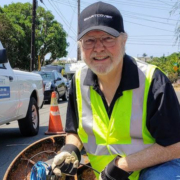New officers for the San Diego County Water Authority’s Board of Directors were elected today, with Gary Croucher starting his two-year term as Board chair on Oct. 1.
Croucher, vice chair of the Board for the past two years as a representative from the Otay Water District, will serve with incoming Vice Chair Christy Guerin, a Board representative from the Olivenhain Municipal Water District, and incoming Secretary Jerry Butkiewicz from the City of San Diego.
Jim Madaffer, who represents the City of San Diego on the Water Authority’s Board, served as chair the past two years. His term ends on Sept. 30.
Collaboration with 24 member agencies ensures plentiful water supply
“The Water Authority is one of our region’s most important institutions, and I’m committed to continuing our long legacy of providing safe and reliable water supplies that sustain 3.3 million people and our $245 billion economy,” said Croucher. “The collaboration with our 24 member agencies is vital to ensure a clean, safe and plentiful water supply for this beautiful place we call home.”
“We are stronger together”
“Looking ahead, Water Authority priorities include assessing the infrastructure necessary to provide water supply reliability for generations to come and leveraging existing infrastructure to increase long-term energy storage. We’re also focused on opportunities to expand partnerships that will benefit our region and the entire Southwest,” Croucher said. “I will also be devoting my personal energy and attention to addressing and resolving concerns two Water Authority member agencies have in seeking detachment from the Water Authority, because I firmly believe we are stronger together.”
He also said that the Water Authority will continue efforts advanced under Madaffer’s leadership to resolve legal disputes over rates with the Metropolitan Water District of Southern California while looking for ways to collaborate with MWD on other issues.
Outgoing Board Chair Madaffer honored
Madaffer, presiding over his last meeting as Board chair, was honored by staff and Board members for his leadership — following on the two-year efforts of his predecessor, Mark Muir, on the rate case litigation, which included securing nearly $500 million dollars from MWD for water supply projects in San Diego County, elimination of illegal charges being imposed on San Diego ratepayers and entry of a final judgment in the 2010 and 2012 cases, and awarding Water Authority almost $45 million. Madaffer also presided over efforts by the Water Authority to minimize rate increases, the development of a new agricultural water rate program to benefit the region’s farmers, and efforts to enhance communication and coordination with member agencies.
New Board Chair is a career firefighter
Incoming Board Chair Croucher joined the Water Authority Board in July 2001 and served as Vice Chair Board for the past two years. He is a member of the agency’s Administrative and Finance Committee and the Legislation and Public Outreach Committee. He’s also chair of the Colorado River Work Group and a member of the MWD Settlement Negotiations Team.
A career firefighter, Croucher retired as an assistant chief for CAL FIRE/San Diego. Croucher is chair of the Border Agencies Fire Council. He is a three-time president of the Otay Water District Board of Directors and former fire chief of the San Miguel Consolidated Fire Protection District. Croucher also serves on the Local Agency Formation Commission’s Borders Committee. He is a past chairman of the Border Agency Fire Council, past president of Southern Area Fire Equipment Research, and he has participated on both state and federal Homeland Security programs.
Guerin is new vice chair
Christy Guerin, the new vice chair, served as Board secretary the past two years, and sits on the Water Authority’s committees for Imported Water and Legislation and Public Outreach, along with the Colorado River Work Group and the MWD Settlement Negotiations Team.
She joined the Board in 2014 representing Olivenhain, where she is a director on the board. Guerin served for a decade with the San Diego County Sheriff’s Department, as mayor of Encinitas from 2002-2006, and as a district director for a member of Congress. She has also served on the SANDAG board, the North County Transit District board and the board of the San Elijo Joint Powers Authority.
Board Secretary Jerry Butkiewicz
Jerry Butkiewicz, the new Board secretary, currently serves as chair of the Water Authority’s Legislation and Public Outreach Committee and sits on the Colorado River Work Group and Water Planning and Environmental committees. He is also one of the Board’s MWD Delegates and serves on the MWD Settlement Negotiation Team He joined the Board in 2016 representing the City of San Diego. Butkiewicz is the former Executive Secretary-Treasurer of the San Diego & Imperial Counties Labor Council.
The Water Authority’s 36-member board, representing 24 retail member water agencies, holds its regular meetings on the fourth Thursday of each month January through October. The November and December meetings are combined, and this year that meeting is November 19. Board meetings have been conducted online since April 2020 due to the coronavirus pandemic and are live-streamed on the Water Authority’s website. Board documents and webcasts of Board meetings are at www.sdcwa.org.








